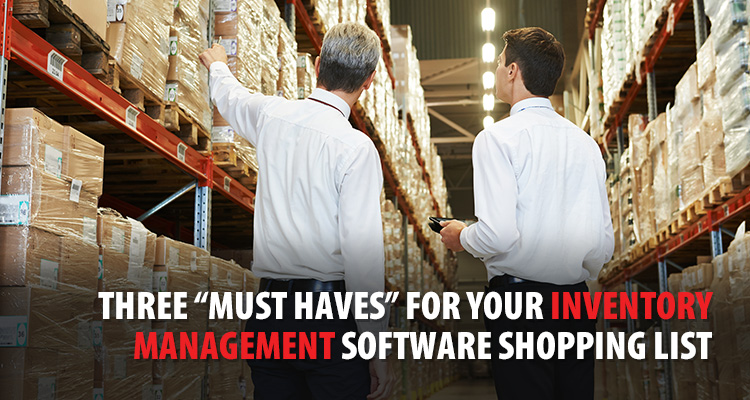Three “Must Haves” for Your Inventory Management Software Shopping List

Lisa Schwarz | Sr. Director of Product Marketing | NetSuite
Shopping around for a new inventory management solution that will help you run your business smarter and more efficiently? Here are three key features to put on your “must have” list.
Companies that receive, store and distribute products have special inventory management needs. For these organizations, managing, controlling, tracking and sharing information about product inventory is a central function that—thanks to smaller orders, higher shipping velocities and changing customer demands—can no longer be managed manually or use disparate technology systems.
That’s where a reliable inventory management system comes in. Using barcodes or radio-frequency identification (RFID), companies know when shipments arrive, when products have shipped, where raw materials are located and exactly how much inventory they have on hand at any given time (and, where that inventory is).
By tracking inventory levels, sales, orders and deliveries, these solutions guarantee a good customer experience, help boost sales and require less capital for inventory. But not all inventory management systems are created equal. Some include advanced planning and forecasting capabilities, while others are more basic.
Ideally, your inventory management solution will give you intelligent control over inventory replenishment, helping ensure that you have enough on hand to fill anticipated orders while keeping excess stock to a minimum. Here are three features that should be on your company’s must-have list for a new inventory management solution:
1. Real-time demand planning functionality. Managing inventory in a warehouse or distribution center (DC) goes beyond just positioning the goods where workers can easily locate, pick and pack them for shipping. It also requires foresight into what customers are (or aren’t) going to want, when they’ll want it and where it will need to be shipped.
To maximize productivity while also saving both money and time, look for an inventory management solution that incorporates real-time demand planning. By using forecasts and historical data, this functionality helps companies accurately predict demand for particular items at specific points within the supply chain.
In return, you’ll get better stock levels, more effective distribution network management, optimized warehousing activities, less need for costly safety stock and more informed decision-making across the entire supply chain.
2. Advanced data analysis tools. Good inventory management doesn’t happen in a vacuum. Using external data analysis tools, companies can leverage the power of predictive analytics and collaborate analytics to make more accurate forecasts and better decisions.
With 66 percent of supply chain leaders saying that advanced supply chain analytics will be “critically important” to their operations over the next two to three years, analytics are imperative in helping companies increase forecast accuracy, optimize transportation performance, improve product tracking and tracing, and analyze returns.
When data analysis and inventory management merge, the end result is a lean, efficient supply chain that helps companies keep their shelves stocked, but not overstocked. Inventory levels can be optimized for all stakeholders across the supply chain, from raw materials to finished goods and all points in between.
Other important wins include reduced inventory costs, higher levels of visibility and better cash flow (i.e., by reducing the amount of working capital that’s invested in inventory). Predictive inventory management also translates into leaner, more efficient supply chains where inventory turnover rates are high, operational productivity is improved and predicting inventory needs across facilities and/or customers is easy.
3. Near- and real-time data and reporting. The days when warehouse managers had to wait until the end of the quarter, the month or even the day to get mission-critical data and reports are long gone. When your inventory management system generates near- or real-time data, you’ll be able to run reports based on the most updated information—not from a month ago or last quarter.
This immediate access to data helps to make better business decisions in an environment where forecasts and demand can literally change from minute to minute. With the most updated information on hand at any given time, warehouse and distribution center managers can operate more efficiently, make better decisions and help their companies be more profitable.
This is especially important for companies with multiple locations or that are managing myriad of different warehouses and distribution centers (DCs). Using reports and analytics, companies can gauge how well they’re doing, where they’re headed and what they need to do differently in the future.
When selecting an inventory management solution, find one that offers real-time data, reporting and user-friendly dashboards that put that data into the hands of managers right when it’s happening. It’s also important that these reports and analytics tool are easily accessible and that they don’t require a Ph.D. in statistics to read, understand and use.
Good Inventory Management Starts Here
By investing in a reliable inventory management system, companies can perform better demand planning and forecasting, figure out what’s selling and what’s not (and then make better buying and planning decisions), order inventory quantities that align with supply and avoid both stock-outs and holding unused inventory.
With good demand planning, external data analysis and optimization tools, your business will be able to keep inventory costs low while consistently meeting customer expectations.
Source: Oracle NetSuite, Three “Must Haves” for Your Inventory Management Software Shopping List






